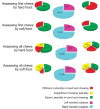Manifestation of hemispheric laterality in chewing side preference and handedness
- PMID: 31508334
- PMCID: PMC6726748
- DOI: 10.15171/bi.2019.23
Manifestation of hemispheric laterality in chewing side preference and handedness
Abstract
Introduction: Humans manifest a behavioral inclination towards more utility of one side of the body, in relation with the dominant hemisphere of the brain. The current investigation assessed handedness together with chewing preference which have not been evaluated in various food textures before. Methods: Nineteen young and healthy volunteers chewed hard (walnut) and soft (cake) foods, during surface electromyography recording from masseter muscles. The side of the first and all chews in the two food types were determined and compared with the side of the dominant hand. Results: Results indicated the two lateralities in the same side considerably (60%-70%), implying the solidarity in the control of the dominant hemisphere of the brain. The unilaterality was more prominent in the assessment of all chews in hard food, with higher statistical agreement and correlation. Conclusion: Thereupon masticatory preference is found with probable origins in the dominant hemisphere of the brain.
Keywords: Chewing laterality; Food texture; Hand-chew preference; Hemispheric dominancy; Masticatory preference.
References
LinkOut - more resources
Full Text Sources


